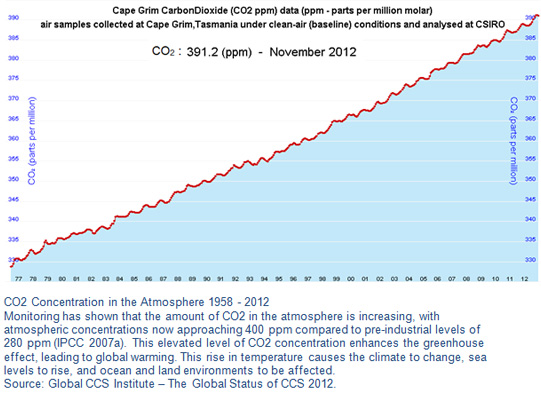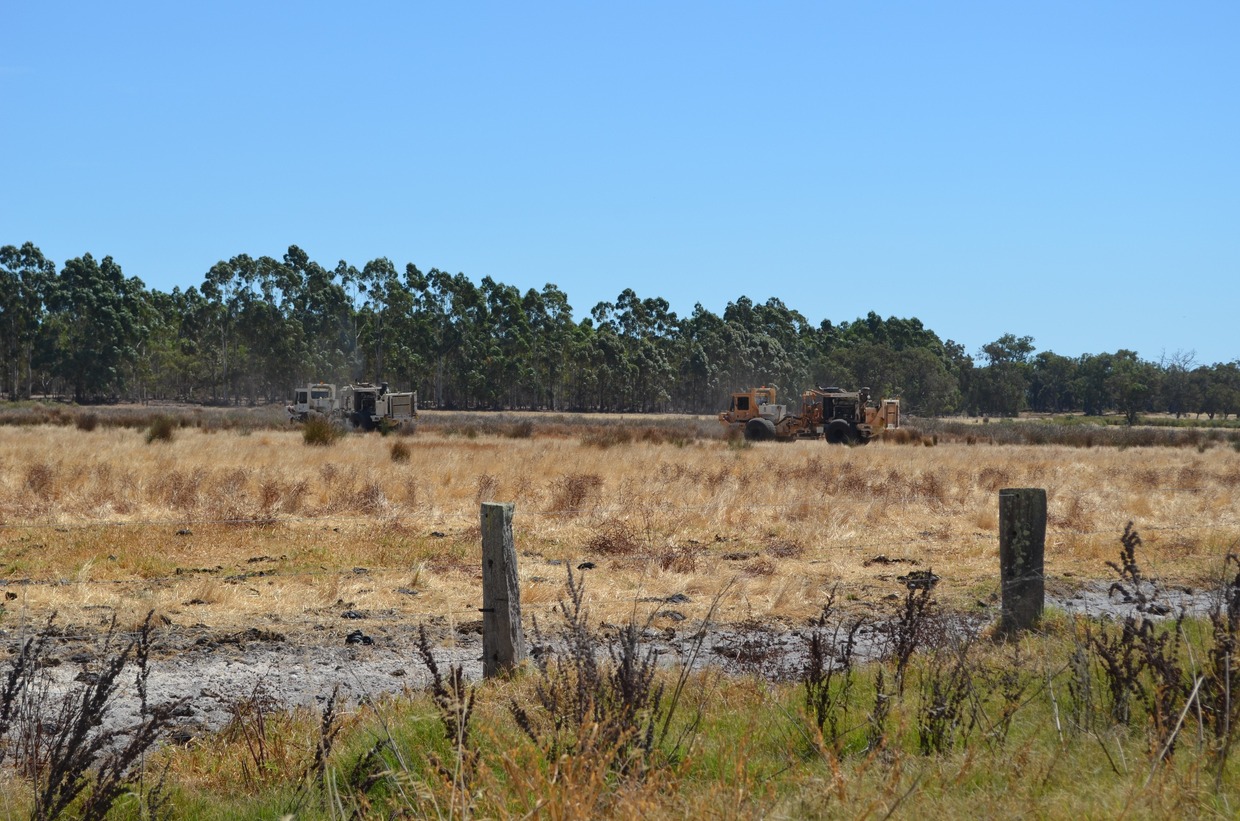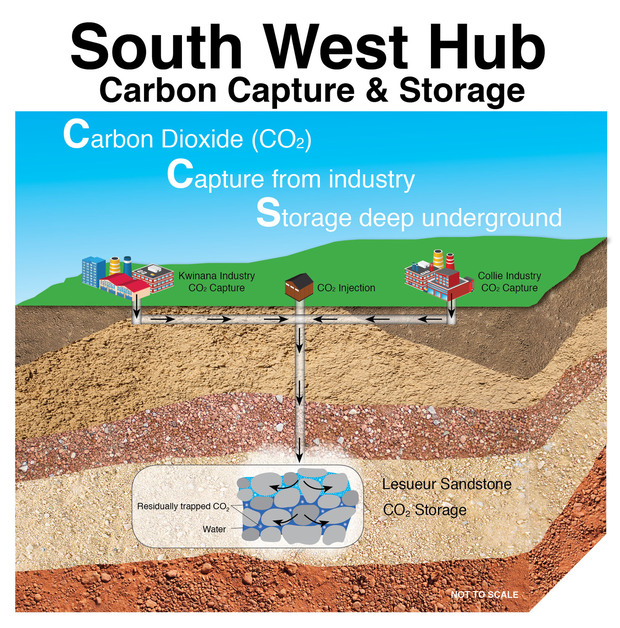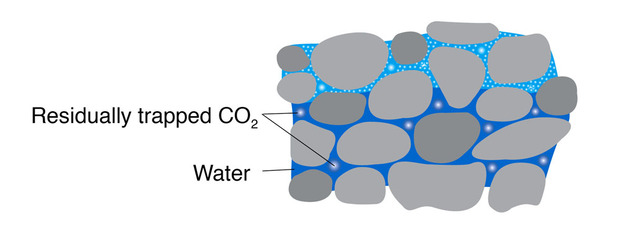What is Carbon Capture and Storage (CCS)?
CCS technology is being developed to reduce the amount of greenhouse gas being released into the earth's atmosphere.
CCS can be broken down into three steps–capture, transport and storage.
Since the industrial revolution around the turn of the 19th century, the combustion of fossil fuels has been increasing the amount of carbon in the atmosphere, in the form of carbon dioxide (CO2).
With CCS the CO2 produced by industry is captured at the point of production, transported via pipeline to an injection site and injected for storage deep underground.
Scientists, economists and governments around the world recognise CCS technology will reduce CO2 emissions while continuing to benefit from fossil fuel energy production.
What is geosequestration?
The trapping of CO2 in deep underground formations is known as geosequestration. CO2 gas can be converted into a supercritical fluid in the presence of heat and compression. These kind of conditions exist below about 800 metres underground, which ensure injected CO2 remains as a supercritical fluid.
In converting CO2 from a gas into a supercritical fluid, its volume is reduced by about 400 times. CO2 in this liquefied state exhibits the properties of both a liquid and gas, and can be permanently stored in sedimentary formations of porous rock, such as sandstone. Underground formations of sandstone, which are saline aquifers, are recognised as suitable reservoirs for permanent CO2 storage.
Ideally, storage reservoirs are covered by a layer of impermeable caprock, to ensure that the CO2 remains permanently trapped deep within the earth. The CO2 remains trapped in a similar way to a naturally occurring gas deposit that has existed deep in the substrata of the earth for millions of years.
What is carbon dioxide?
It is a colorless, odorless, non-flammable and non-toxic gas. CO2 is heavier than air and soluble in water. A single CO2 molecule is made up of one carbon atom and two oxygen atoms.
It is exhaled in your breath and is not deadly to inhale, provided you are inhaling sufficient oxygen. CO2 is also produced as a by-product of the combustion of fossil fuels such as coal, oil and natural gas. It has many uses both in the natural and industrial world. A fundamental process necessary for green plant life involves trees absorbing CO2 from the atmosphere to grow, and releasing oxygen back into the atmosphere as part of photosynthesis.
CO2 is used abundantly by humans. It is used in winemaking, carbonated drinks, fire extinguishers and refrigeration, and is an essential ingredient for bi-carb soda.
How is carbon dioxide linked to the greenhouse effect?
CO2 is the primary greenhouse gas emitted through human activities. A greenhouse gas contributes to global warming because it absorbs thermal radiation (effectively the warmth of the sun) and prevents it from leaving earth’s atmosphere.
Climate scientists are almost certain that anthropogenic or man-made CO2 released into the atmosphere is contributing to adverse climate change.
Since the beginning of the industrial revolution in the late 18th century, people have been burning fossil fuels to produce energy at an increasing rate. Burning fossil fuels produces CO2 which, when emitted into the Earth’s atmosphere, becomes a greenhouse gas and contributes to global warming.
Since the industrial revolution the burning of fossil fuels has contributed to a 40 per cent increase in the atmospheric concentration of carbon dioxide, from 280 to 392.6 parts-per-million (ppm).
What is the surface impact of geosequestration?
A demonstration of geosequestration is underway at Otway in Victoria, where CO2 is being extracted from natural deposits and re-injected into an underground reservoir.
An injection site has a small footprint at surface and may consist of a compressor within a large farm shed, pipes and instrumentation leading into the ground. It is expected that this will be located on a site smaller than one hectare.
Equipment used to monitor the underground CO2 plume can also be seen in nearby paddocks.
What is the impact of geosequestration on freshwater aquifers?
CCS injection sites are carefully selected after sophisticated seismic analysis and extensive testing. This means CO2 reservoirs will not be connected to any reserves of freshwater or water for industrial use.
The preferred storage sites are geological formations of porous sandstone that are saline aquifers. This means they do not contain potable water that could be used to supply drinking water.
The South West Hub is assessing the feasibility of using the Lesueur Sandstone formation as a CO2 reservoir. The Lesueur is a saline aquifer where the water is saltier than seawater.
The Lesueur lies between 1.4 and 3 kilometres underground, and has a salinity greater than 35,000 parts per million. Drinking water is approximately 450 parts per million and the World Health Organisation recommends salinity levels above 1200 parts per million are unacceptable for human consumption.
Due to the presence of a geological uplift in the series of stratigraphic formations in the Harvey–Waroona area, the major source of underground freshwater in the South West, the Yarragedee Aquifer, was eroded away from this area about 130 million years ago.
There are no deep potable water sources in the area, which eliminates any risk of CO2 mixing with important freshwater sources.
The presence of surface water, superficial aquifer and the Leederville aquifer at shallow depths are acknowledged; however, these water supplies are significantly above the 800 metre depth.
How is the carbon dioxide trapped in rock?
There are four ways that CO2 can be trapped within a formation of sandstone in a saline aquifer. These include a local trapping mechanism, where CO2 bubbles snap off and remain contained within the pore space of the sandstone, as well as dissolving and mineralisation. It also includes a physical trapping by an impermeable sealing layer such as shale, which can stop CO2 from migrating toward the surface.
CO2 occurs in naturally formed underground reservoirs. Natural oil and gas reservoirs, which may also contain CO2, remain sealed for millions of years.
Geological rock formations deep underground are considered ideal storage locations for CO2. Suitable sites have the following characteristics:
- a reservoir unit, usually sandstone, into which CO2 can be injected
- reservoir rocks that may include depleted natural oil and gas fields and deep formations filled with saline water
- an overlying impermeable sealing unit, most usually shale rock, which stops the CO2 migrating out of the reservoir towards the surface
- geological stability.
Data and samples collected in the Harvey–Waroona area from the Lesueur Sandstone formation confirm its potential as a suitable CO2 reservoir.
Can the carbon dioxide leak to the surface?
It is unlikely that CO2 will migrate to the surface from an underground reservoir after a CCS project has met the requirements of government licensing.
When applying for an injection licence a company will be required to undertake rigorous assessment. This ensures the nominated storage site has an appropriate trapping mechanism and seal, and is a suitable reservoir for long-term CO2 containment.
Sites that meet these requirements will need to be licensed and monitored, and a site closure certificate will not be issued until at least 15 years after operations cease. In the unlikely occurrence that CO2 migrates to the surface, a gradual slow release of CO2 would be expected–similar to the everyday release of CO2.
Natural geological structures have sealing layers or caprock that has kept large volumes of oil and gas in place without any measurable leakage for millions of years.
Data acquired by the South West Hub indicates the upper part of the Lesueur Sandstone, known as the Yalgorup Member, consists of sandstone and mudstone. These features could act as a seal and provide a tortuous path for gases in the unlikely event of any leakage.
What safeguards are in place to ensure there are no carbon dioxide leaks?
Amendments to existing laws governing petroleum and geothermal energy resources in Western Australia will introduce Exploration Licences, Retention Leases and Injection Licences for the underground acreage where greenhouse gases such as CO2 may be stored.
Companies will require a licence approved by the Minister for Mines and Petroleum before CO2 can be injected and stored underground through geosequestration.
Licensed companies will be required to monitor and provide regular reports to the department regarding the injected CO2 behaviour.
Injection sites will be subject to regular inspections from government agencies.
Under planned amendments to the State's legislation, a monitoring and verification plan will be mandatory prior to conducting any injection operations.
Such plans include company responses to non-routine situations, including losses and migration of CO2, as well as pressure reduction and other leakage markers.
If the CO2 is not behaving as predicted, companies would be able to act immediately to mitigate the leak.
The Weyburn experience
Q: There was a study that alleged CO2 was leaking from the Weyburn Oil Field in western Canada, which is one of the largest CCS projects in the world. Is this really happening and could it occur at the South West Hub Project?
A: In January 2011 a landowner in the area of the Weyburn Oil Field in Saskatchewan, Canada, made a claim that CO2 was leaking out of the oil field into their soil. CO2 is injected into this oil field to help with oil recovery but it eventually remains in the reservoir. At the time of this claim, injection had been occurring for almost a decade and about 20 million tonnes of CO2 had been stored.
The basis of the landowner's claim was a report by a contractor hired by the landowner. The contractor collected samples of soil gases at a number of locations on the property and measured both the concentration of CO2 in the soil gases and another chemical attribute, the stable isotopic composition of the carbon in the CO2. The contractor interpreted the concentrations and isotopic compositions of CO2 in the soil gas to indicate the CO2 was leaking from the oil reservoir 1.5 kilometres below the surface. This interpretation was scientifically flawed and highly inaccurate.
The Weyburn Oil Field was also the site of a very large scientific study called the IEAGHG Weyburn-Midale CO2 Monitoring and Storage Project, which examined the storage and monitoring of CO2 in geological formations. This study had been ongoing before CO2 injection even started at the oil field and ultimately involved more than 100 researchers from numerous independent global research organisations. As part of this study, the soil gases had been tested and sampled above the oil reservoir, and in nearby crop fields not above the reservoir before injection started - termed baseline. The gases had also been periodically tested during injection, known as monitoring. The concentrations of CO2 in soil gases from the baseline surveys, along with published scientific studies of soil gases from other numerous agricultural and soil studies, indicated the chemical values of soil gases remained consistent with natural levels. More importantly, the values of CO2 measured by the contractor were also consistent with the region's expected natural CO2 in soils. As such, there was no scientific evidence to support the allegation that any CO2 was leaking.
A separate international group of scientists not associated with the project also examined the soil gases, applying more sophisticated techniques and systematic sampling methodologies. These studies indicated leakage was not occurring and the CO2 in the soil gases was a result of natural processes.
The above studies highlight the importance of performing baseline and early monitoring surveys, particularly for shallow groundwater, soil gas and seismic. Each geological site is unique, and South West Hub differs from Weyburn in several ways. One of the main differences is Weyburn features more than 1000 wells, many of which are old and drilled in years when protocols were less rigorous. The South West Hub would have only very few wells, each drilled with modern methods and materials. The geological setting at Weyburn differs from the South West Hub and that is why the 3D seismic program is so important to establish the configuration of the deep geological formations. The purpose of geological mapping and studying and performing baseline and monitoring surveys at the South West Hub is to identify any risks of potential leakage so they may be assessed prior to injection.
What makes the Lesueur sandstone a good reservoir for carbon dioxide?
Lying underneath the Leederville and Eneabba Formations, the Lesueur Sandstone is composed of two units - the Yalgorup (704 -1380m) and Wonnerup (1380-2895m) Members. The Wonnerup is where the CO2 would be permanently trapped.
Research confirms that the Wonnerup Member is a massive 1.5 kilometre-thick formation of clean, coarse-grained sandstone, possessing good porosity and permeability properties for a CO2 reservoir. Research also shows that CO2 can move horizontally more easily than vertically in the reservoir.
Lying above the Wonnerup is the Yalgorup Member, which could have trapping potential as it consists of interbedded sand and shale layers. The variation in salinity levels between the Yalgorup and Wonnerup indicate that layers of shale provide a potential sealing unit and there is no connectivity between the aquifers.
Why CCS?

We rely on fossil fuels for energy. Until a suitable replacement appears, we will continue to use them. CCS means we can continue to rely on these investments.
Burning fossil fuels releases CO2, which is most often dispersed into the atmosphere where it becomes a greenhouse gas.
Developing CCS technology is one way we can help lower CO2 emissions into the atmosphere. It is crucial to slowing climate change until alternative, less carbon-intensive generation technologies are more broadly in use.
Renewable technologies include the capturing of energy from solar, wind, wave and geothermal sources, as well as increasing our energy efficiency.
CCS is an achievable method that will deliver part of the solution to the problem of high carbon emissions into the atmosphere and help Australia meet its target of an 80 per cent cut to greenhouse gas emissions by 2050.
How is the CO2 trapped in rock?
CO2 occurs in naturally formed underground reservoirs. Natural oil and gas reservoirs, which may also contain CO2, remain sealed for millions of years. Geological rock formations deep underground are considered ideal storage locations for CO2. Suitable sites have the following characteristics:
A reservoir unit, usually sandstone, into which the CO2 is injected. Suitable reservoir rocks may include depleted natural oil and gas fields and deep formations filled with saline water. An overlying impermeable sealing unit, most usually shale rock, which stops the CO2 migrating out of the reservoir towards the surface.
Geological stability.
Data and samples collected in the Harvey–Waroona area from the Lesueur Sandstone formation confirm its potential as a suitable CO2 reservoir.
Is CCS a proven technology?
The individual technological components of CCS are well understood and being used in successful projects in Norway, Algeria, Canada and the United States of America.
Naturally occurring underground rock formations have stored enormous quantities of petroleum (hydrocarbons), as well as other gases such as CO2, for millions of years.
For decades, the energy industry has used the injection of CO2 to increase oil recovery from deep geological formations in a process known as enhanced oil recovery. Petroleum is also routinely stored underground in depleted hydrocarbon reservoirs.
In Victoria, the Cooperative Research Centre for Greenhouse Gas Technologies (CO2CRC) is operating the Otway Project, near Port Campbell. This is Australia's first demonstration of CO2 geosequestration or geological storage. The Otway project has demonstrated that CO2 can be safely transported, injected, stored and monitored.
What CCS projects are in Western Australia?
Chevron Australia’s Gorgon Project on Barrow Island will incorporate one of the world's largest carbon dioxide injection projects. The Project will inject and store reservoir carbon dioxide into a deep reservoir unit more than two kilometres beneath the ground - reducing Gorgon’s greenhouse gas emissions by approximately 40 per cent.
Nation-wide, there are other projects involving CCS and they are listed on the CO2CRC website.



